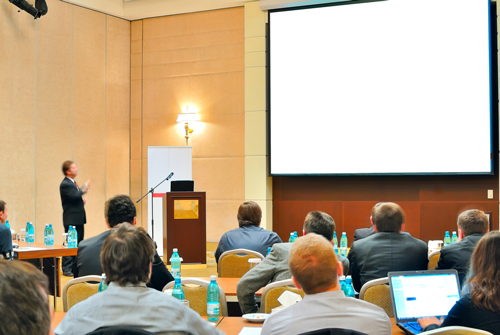It’s significant that the phrase ‘death by PowerPoint’ has entered general terminology among corporate meeting participants. Too many people have experienced meetings dominated by the mind-numbing misapplication of PowerPoint. The technology isn’t necessarily to blame, however—people need to know how to make the best use of it. PowerPoint can be an invaluable asset to your meeting, after all. That being the case, here are five ways to avoid death by PowerPoint in meetings:
Know Your Material
Have you ever been in a meeting that consisted of the so-called speaker merely reading their PowerPoint slides out loud, from beginning to end? This is one of the worst ways to make use of a slideshow. Slides are meant to supplement spoken information, not replace it. If your words and slides are the same, you’re just being redundant. A good speaker won’t use PowerPoint as a crutch, but will provide information that backs up their spoken words and assists participants in understanding the material covered during the meeting.
Avoid Excess
The tricky thing about PowerPoint presentations is that they risk distracting meeting attendees from the importance of the meeting and what the speaker needs participants to grasp. This is especially likely to happen if a slide contains a lot of words or volumes of spreadsheet type data. How will people pay attention to what you’re saying if they’re busy reading the thousand words crammed into one slide? Or they can’t read the small font of a screenshot taken of a spreadsheet. The best slides only include crucial information, with the right words that will not demand a viewer’s attention for too long.
Incorporate Variety
PowerPoint presentations should not be limited to words or data on slides. Sometimes a good visual can go a long way. Break the monotony of the meeting with an on-point illustration such as a story and corresponding funny or serious photo. Graphs and charts, keep minimal, can be a great way to convey necessary statistics. Graphics and photos can also help set a tone, providing a conceptual backdrop for whatever a speaker is saying. In addition to these images, why not incorporate a short video? Utilizing a variety of mediums will help keep your meeting attendees engaged. Show your team what it’s really like in a production room, what customers are really saying, how a new product actually is set up or works for example.
Consider the Visuals
PowerPoint presentations are a visual medium. That being the case, the visual details are worth getting right. For example, bright red fonts on a white background might be painfully jarring to the eye. Similarly, yellow font on a white background could be too difficult to see. Font size is also important: viewers shouldn’t have to squint to read your slides. Fonts are not the only necessary consideration, however. If you’re using images, don’t settle for boring and cliché clip art. Finding something creative and memorable is much better. There are plenty of outstanding stock photography sources online, but even better are those which are taken internally. Oh, and make sure you get the frame rate right. Nobody likes an image too blurry to see clearly.
Strategic Pacing
Pacing is another important element of your presentation. Meeting attendees need to be able to follow along. If there’s necessary information in your slides, you don’t want to skip to the next slide before people can digest the information. Likewise, it often helps to avoid speaking while attendees are reading your slides. Slides should not contain unnecessary information, so make sure your guests can digest what you present as well as what you speak. Don’t feel the need to rush, or worry that silence is an enemy. Sometimes the best thing you can do is remain silent while people process the information in your slide.
Conclusion
PowerPoint is a helpful tool. When used properly, it can help a speaker communicate effectively and bolster a meeting’s efficiency. If you keep these five tips in mind you can finally lay Death by PowerPoint to rest.
Preparing for a meeting requiring participants to travel to the same location? Contact Gavel for more information on meeting planning.
This article was last updated on November 28, 2022
- Incentive Trailblazing with John George in Banff, Canada - December 4, 2023
- Nature’s Playground: Big Sky and Bozeman, MT - September 26, 2022
- Yellowstone National Park - September 12, 2022






